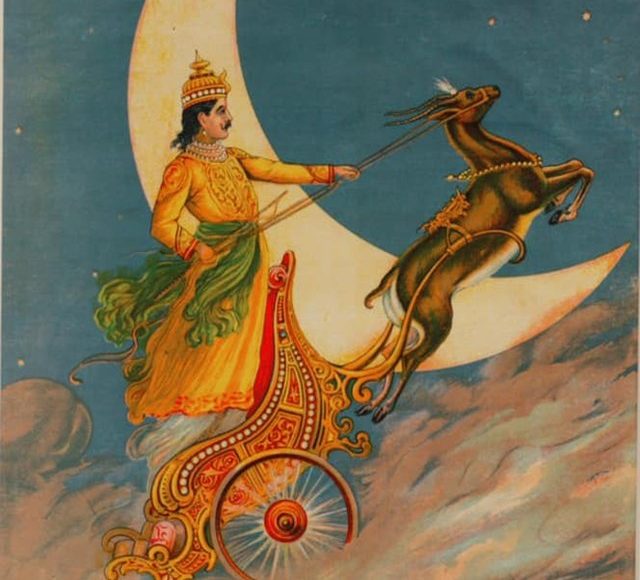CHANDA, CHANDRAMA (CHANDRA, SOMA) (Chandra) abides in the forehead of Shiva and bathes in the Ganges; though in his dynasty (Lunar) came Krishna, the incarnation of Vishnu (who has a bow in his hand), but still the blemish due to his past action (of acting as an accomplice of Indra in the seduction of Ahalya and abduction of Tara, the wife of Brahaspati) in not effaced. (Dhanasari Trilochan, p. 695) The sun and moon (Chanda) work under the Fear of the Lord; they traverse millions of miles and there is no end to their movement. (Var Asa M. l, p. 464) In the Puranas, the moon is generally called Chanda or Soma. He came out from the milk-ocean, as a jewel when it was churned by gods and demons. Shiva took the moon as it emerged from the ocean.
It is also written that Chandra was the son of Surya. It is also said that he was the son of Atri. The Lunar dynasty of kings begins from him. Chandra married the daughters of Daksha, the fourth of whom Rohini, was his favourite one. For this partiality the other daughters complained to their father. Daksha argued with him and on his insistence cursed him with a consumption that continued for fifteen days and at the end of which he repented. Daksha, then, restored him to health in fifteen days. That explains the fluctuations in the appearance of the moon.
He acted as the accomplice of Indra in the seduction of Ahalya and received a permanent blemish on his face. Chandra is also famous for the criminal passion of Tara, the wife of god Brahaspati and abducted her. For this sinful act, Varuna, his father (Because Varuna is the god of ocean and Chandra was bom from the ocean) felt greatly ashamed, but his sister Lakshmi wanted to restore the honour of his dishonoured brother. She asked Parvati to influence her husband god Shiva for this. On her appeal, in order to exalt Chandra, Shiva wore him on his forehead. See : Shiva and Indra
References :
1. Kohli, Surindar Singh (ed), Dictionary of Mythological References in Guru Granth Sahib, 1993
In Hindu mythology, Chanda and Chandrama hold distinct significance:
- Chanda: Often associated with the demons Chanda and Munda, who were defeated by Goddess Kali in the Devi Mahatmya. These demons symbolize darkness and evil forces that the divine must overcome. Additionally, “Chanda” can refer to the Moon in certain contexts, as it is sometimes used interchangeably with “Chandrama” in Sanskrit texts.
- Chandrama: Known as the Moon God, Chandrama is one of the Navagrahas (nine celestial bodies) in Hindu astrology. He is depicted as a deity of night, vegetation, and fertility. Chandrama is said to ride a chariot pulled by antelopes and is associated with the lunar dynasty. His stories include marrying the 27 daughters of Daksha and favoring Rohini, which led to a curse that explains the waxing and waning of the moon.
In the Guru Granth Sahib, both Chanda and Chandrama are referenced metaphorically:
- Chanda and Chandrama are mentioned as celestial entities that operate under divine command, symbolizing the cosmic order and the omnipresence of the Creator.
- Chandrama is also noted for its mythological ties, such as being worn on Lord Shiva’s forehead, representing divine favor and the interconnectedness of creation.




